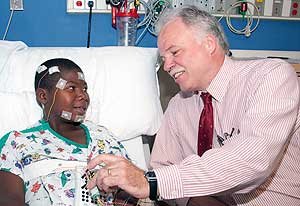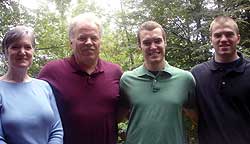James Kemp, M.D., began his medical career on the poorest Indian reservation in the country shortly after two high-profile incidents amplified tensions between the U.S. government and American Indians.

In the mid-1970s, on the Pine Ridge Indian Reservation in southwest South Dakota, two separate confrontations between the government and activists known as the American Indian Movement left four FBI agents and three American Indians dead.
As part of a U.S. Public Health Service scholarship, Kemp went to the Indian Health Service at Pine Ridge in 1979 as a pediatrician fresh from residencies at SSM Cardinal Glennon Children’s Medical Center in St. Louis and Baylor College of Medicine in Houston. As a South Dakota native, Kemp felt called to serve in his home state.
“Pine Ridge was a place with a long tradition of adventurous physicians who wanted to be in exciting places,” says Kemp, professor of pediatrics and a pulmonologist at St. Louis Children’s Hospital. “It was very interesting, but it was dangerous also — it was a very violent place.”
Some of the patients he saw were distrustful of him and the other physicians at Pine Ridge.
“They thought if we were any good we’d be practicing in the suburbs someplace,” he says.
But the reservation’s people, the Oglala Sioux, had serious and complicated health problems that required good physicians.
“I’d done residencies in large urban areas, and in this place, I saw every single problem I’d seen as a resident — congenital heart disease, septic shock, premature births — but I was in the middle of a place where the nearest substantial hospital was 120 miles away,” he says. “I was 29, and I was it.”
The inspiration
Kemp’s desire to become a pediatrician bloomed early in life. His mother, Peggy Kemp, now 84, was a nurse in a children’s rehabilitation hospital.
“She taught me the impact on families when bad things happen to kids and the importance of those kids having fun in their lives,” he says. “When my brothers and I would go to see her at work, we saw how much fun she had with kids who were very unlucky.”
Kemp also was influenced by one of his clinical professors at Creighton University School of Medicine, Warren Bosley, M.D.
“When I did an elective with him, I saw how his attitude toward what he was doing was so lighthearted,” he says. “His patients were sick, but his attitude was ‘We’re in this to serve the patient, we’re in this to have some fun with what we’re doing, and my job is to see to it that the kid gets back to being a kid.'”
Kemp took that attitude to heart, says Alan L. Schwartz, Ph.D., M.D., the Harriet B. Spoehrer Professor and head of the Department of Pediatrics.

“Jim Kemp is a superior clinician, a state-of-the-art expert in both pulmonary diseases of children and sleep disorders, an engaging bedside teacher and a critical thinker and scholar,” Schwartz says. “He is always asking deep questions of pathophysiology and how to minimize disease burden on children.”
Sharpening the focus
After two years with the U.S. Public Health Service, Kemp entered private practice as a pediatrician in Mitchell, S.D. Looking to specialize, he returned to Baylor College of Medicine and Texas Children’s Hospital for a three-year fellowship in pediatric pulmonary medicine, the start of his career as a “sleep doctor.”
“I got into this area because I am interested in the control of breathing in babies,” he says. “As a pulmonologist, I see lots of kids with problems with breathing during sleep because of diseases like muscular dystrophy or obstructive sleep apnea, cleft palate and obesity.”
Kemp came to the School of Medicine and St. Louis Children’s Hospital in 1989 as an instructor in pediatrics. He worked with Bradley Thach, M.D., professor of pediatrics, studying sudden infant death syndrome (SIDS) and working in the new sleep lab at St. Louis Children’s Hospital. Kemp and Thach studied how the sleep environment around a baby’s face might compromise the baby’s breathing.
“Our approach to babies dying in the prone (face down) position was that they weren’t getting access to fresh air,” he says. “If they were sunk down on a pillow, they would be exchanging air only with the inside of the pillow, leading to subtle suffocation.”
Kemp and Thach have worked with the U.S. Consumer Products Safety Commission for many years to develop safety standards for cribs and infant bedding.
Thanks in part to their research, the American Academy of Pediatrics’ Back to Sleep campaign launched in 1994, encouraging parents to place their babies to sleep on their backs to avoid suffocation from pillows, stuffed animals, comforters and bumper pads in the crib. Because of the campaign, Kemp says, most infant deaths no longer occur in cribs — babies are dying from sharing beds or couches with adults.
“We have a situation in the United States where SIDS is going down, but infant deaths are staying the same,” Kemp says. “One reason is the diminished impact of Back to Sleep in high-risk populations. Another reason is the high rates of bed sharing. Probably 70 percent to 80 percent of babies who die during sleep die sleeping with their parents, and we’re dealing with how to address that now.”
In 2007, Kemp was named co-leader of an $11 million grant from the Bill & Melinda Gates Foundation funding a campaign to prevent infant deaths from bed sharing. The grant, awarded to Baltimore-based First Candle, funds a pilot program in three states that will distribute nearly 250,000 cribs to needy families and educate them about the benefits of using cribs.
“Among poor families, the primary reason people sleep with their kids is they can’t afford a bed,” he says. “There is also a controversy that bed-sharing is good because it promotes breastfeeding, but there are other ways to increase rates of breastfeeding.”
|
James Kemp |
|
Family: Wife, Debra, clinical research nurse coordinator in the Center for Clinical Studies; son Philip, a recent graduate of Columbia University in New York; son Patrick, a junior at Macalester College in St. Paul, Minn. Hobbies: Travel, fishing and biking Senior rock groupie: Kemp unwinds by going to small venues to listen to rock bands. Some of his favorites are Javier Mendoza, Dave Alvin and the Guilty Men, The Blasters and the Asylum Street Spankers. Reading: “Traitor to His Class: The Privileged Life and Radical Presidency of Franklin Delano Roosevelt” by H.W. Brands |
Kemp’s colleagues say he is a national leader in infantile apnea with an infectious passion for teaching.
“His seminal work with Brad Thach provided the mechanism by which prone positioning led to sudden infant death syndrome and profoundly changed clinical practice,” says Thomas W. Ferkol, M.D., professor of pediatrics and of cell biology and physiology, director of the Division of Allergy and Pulmonary Medicine and of the Cystic Fibrosis Center at St. Louis Children’s Hospital. “Under his leadership, the pediatric sleep center and laboratory are becoming a regionally visible, interdisciplinary program, meeting the needs of the community and the medical center.”
In the clinic
Although Kemp is renowned nationwide for his research into safe sleep practices, his main role is treating children with sleep problems, such as obstructive sleep apnea, which occurs when the upper airway narrows as the muscles relax naturally during sleep. This reduces oxygen in the blood and causes arousal from sleep. He is co-director of the Pediatric Sleep Diagnostics Laboratory and Sleep Disorders Clinic at the hospital.
Kemp says removing tonsils and adenoids resolves the problem in up to 80 percent of children. But the children he treats are the ones whose problems don’t improve after surgery.
“Some kids have terrible obstructive sleep apnea due to obesity, big tonsils, craniofacial malformations and Down syndrome,” he says. “Figuring out how to address their clinical problems is something that we’re working on here. It’s rewarding, but also very challenging.”
Much of the challenge is encouraging young children with obstructive sleep apnea to wear CPAP (continuous positive airway pressure) masks, which help to keep the airway open while they sleep. The only other option these children have is a tracheostomy, or surgically cutting a hole in the throat.
Kemp gives much of the credit for getting children to use the CPAP machines to the hospital’s staff on 7 East and in Child Life Services.
“The Child Life staff has created games parents can play with their kids to get them to wear the mask to sleep,” he says. “That’s the great thing about working at St. Louis Children’s Hospital — you’ve got somebody whose job it is to do these kinds of things that may seem goofy to those caring for adults, but it’s absolutely essential to being successful.”
Kemp’s success with his patients is evident in a young cystic fibrosis patient who recently graduated from high school with plans to become an engineer. But when that patient was in middle school, he was so unhappy that he considered dropping out of school.
“I told him, ‘I’m not going to buy cystic fibrosis as an excuse for you not being a success,'” Kemp recalls. “He is smart and ‘worth it,’ and I knew him well enough that I could talk that way. He didn’t want to fall behind and drop out, either — he wanted to amount to something. So he found a new school and blossomed. And that’s why I do what I do.”